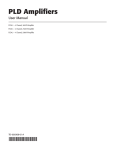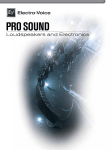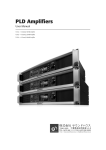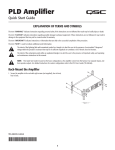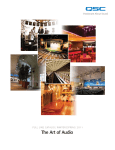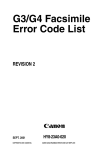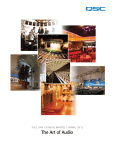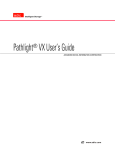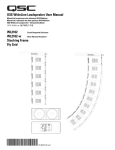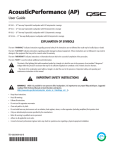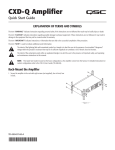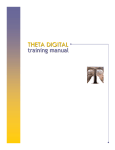Download QSC MD-SP218 User manual
Transcript
CXD Amplifiers User Manual CXD4.2 — 4 Channel, 1600 W Amplifier CXD4.3 — 4 Channel, 2500 W Amplifier CXD4.5 — 4 Channel, 5000 W Amplifier TD-000367-01-A *TD-000367-01* EXPLANATION OF SYMBOLS The term “WARNING!” indicates instructions regarding personal safety. If the instructions are not followed the result may be bodily injury or death. The term “CAUTION!” indicates instructions regarding possible damage to physical equipment. If these instructions are not followed, it may result in damage to the equipment that may not be covered under the warranty. The term “IMPORTANT!” indicates instructions or information that are vital to the successful completion of the procedure. The term "NOTE" is used to indicate additional useful information. The intent of the lightning flash with arrowhead symbol in a triangle is to alert the user to the presence of un-insulated "dangerous" voltage within the product's enclosure that may be of sufficient magnitude to constitute a risk of electric shock to humans. The intent of the exclamation point within an equilateral triangle is to alert the user to the presence of important safety, and operating and maintenance instructions in this manual. IMPORTANT SAFETY INSTRUCTIONS WARNING!: TO PREVENT FIRE OR ELECTRIC SHOCK, DO NOT EXPOSE THIS EQUIPMENT TO RAIN OR MOISTURE. • Keep these instructions. • Heed all warnings. • Follow all instructions. • Do not use this apparatus near water. • Clean only with a dry cloth. • Do not block any ventilation opening. Install in accordance with the manufacturer's instructions. • Do not install near any heat sources such as radiators, heat registers, stoves, or other apparatus (including amplifiers) that produce heat. • Do not defeat the safety purpose of the polarized or grounding-type plug. A polarized plug has two blades with one wider than the other. A grounding type plug has two blades and a third grounding prong. The wide blade or the third prong are provided for your safety. If the provided plug does not fit into your outlet, consult an electrician for replacement of the obsolete outlet. • Protect the power cord from being walked on or pinched particularly at plugs, convenience receptacles, and the point where they exit from the apparatus. • Only use attachments/accessories specified by the manufacturer. • Unplug this apparatus during lightning storms or when unused for long periods of time. • Refer all servicing to qualified service personnel. Servicing is required when the apparatus has been damaged in any way, such as power-supply cord or plug is damaged, liquid has been spilled or objects have fallen into the apparatus, the apparatus has been exposed to rain or moisture, does not operate normally, or has been dropped. • The appliance coupler, or the AC Mains plug, is the AC mains disconnect device and shall remain readily operable after installation. • Adhere to all applicable, local codes. • Consult a licensed, professional engineer when any doubt or questions arise regarding a physical equipment installation. TD-000367-01-A 2 FCC Statement NOTE: This equipment has been tested and found to comply with the limits for a Class A digital device, pursuant to Part 15 of the FCC Rules. These limits are designed to provide reasonable protection against harmful interference when the equipment is operated in a commercial environment. This equipment generates, uses, and can radiate radio frequency energy and, if not installed and used in accordance with the instruction manual, may cause harmful interference to radio communications. Operation of this equipment in a residential area is likely to cause harmful interference in which case the user will be required to correct the interference at his own expense. RoHS STATEMENT The QSC CXD4.2, CXD4.3 and CXD4.5 amplifiers are in compliance with European Directive 2002/95/EC – Restriction of Hazardous Substances (RoHS). The QSC CXD4.2, CXD4.3 and CXD4.5 amplifiers are in compliance with “China RoHS” directives. The following chart is provided for product use in China and its territories: QSC CXD4.2, CXD4.3, and CXD4.5 Amplifiers 部件名称 (Part Name) 有毒有害物质或元素 (Toxic or hazardous Substances and Elements) 铅 (Pb) 汞 (Hg) 镉 (Cd) 六价铬 (Cr(vi)) 多溴联苯 (PBB) 多溴二苯醚 (PBDE) 电路板组件 (PCB Assemblies) X O O O O O 机壳装配件 (Chassis Assemblies) X O O O O O O: 表明这些有毒或有害物质在部件使用的同类材料中的含量是在 SJ/T11363_2006 极限的要求之下。 (O: Indicates that this toxic or hazardous substance contained in all of the homogeneous materials for this part is below the limit requirement in SJ/T11363_2006.) X: 表明这些有毒或有害物质在部件使用的同类材料中至少有一种含量是在 SJ/T11363_2006 极限的要求之上。 (X: Indicates that this toxic or hazardous substance contained in at least one of the homogeneous materials used for this part is above the limit requirement in SJ/T11363_2006.) TD-000367-01-A 3 Warranty (USA only; other countries, see your dealer or distributor) QSC Audio Products 3 Year Limited Warranty QSC Audio Products, LLC (”QSC”) guarantees its products to be free from defective material and/or workmanship and will replace defective parts and repair malfunctioning products under this warranty when the defect occurs under normal installation and use, provided the unit is returned to our factory, one of our authorized service stations or an authorized QSC International Distributor via pre-paid transportation with a copy of proof of purchase (i.e., sales receipt). This warranty provides that the examination of the return product must indicate, in our judgment, a manufacturing defect. This warranty does not extend to any product which has been subjected to misuse, neglect, accident, improper installation, or where the date code has been removed or defaced. QSC shall not be liable for incidental and/or consequential damages. This warranty gives you specific legal rights. This limited warranty is freely transferable during the term of the warranty period. The warranty on QSC products is NOT VALID if the products have been purchased from an unauthorized dealer/online e-tailer, or if the original factory serial number has been removed, defaced, or replaced in any way. Damage to, or loss of any software or data residing on the product is not covered. When providing repair or replacement service, QSC will use reasonable efforts to reinstall the product’s original software configuration and subsequent update releases, but will not provide any recovery or transfer of software or data contained on the serviced unit not originally included in the product. Customers may have additional rights, which vary from state to state or from country to country. In the event that a provision of this limited warranty is void, prohibited or superseded by local laws, the remaining provisions shall remain in effect. The QSC limited warranty is valid for a period of three (3) years from date of purchase in the United States and many (but not all) other countries. For QSC warranty information in countries other than the United States, contact your authorized QSC international distributor. A list of QSC International distributors is available at www.qsc.com. To register your QSC product online, go to www.qsc.com and select ”Product Registration”. Other questions regarding this warranty can be answered by calling, e-mailing or contacting your authorized QSC distributor. Phone: 1-800-854-4079 within US and Canada, +1-714-754-6175 international, Email: [email protected], Website: www.qsc.com. TD-000367-01-A 4 Introduction Built for system integrators, the CXD series amplifiers provide multi-channel amplification with built-in DSP and enough power to drive wide varieties of speaker systems with optimal energy efficiency. The CXD Series consists of three light-weight, 2RU, four-channel amplifiers with on-board DSP and flexible channel combining as well as 70V and 100V direct drive. These amplifiers not only provide the power and processing to make your system perform better, they offer outstanding efficiency ensuring that energy costs are kept to a minimum over the life of the installation. CXD amplifiers feature Flexible Amplifier Summing Technology (FAST). Depending on the model, 1600, 2500, or 5000 Watts of total power can be distributed across one to four outputs. In addition, the CXD4.3 and CXD4.5, can drive 70V or 100V speaker lines directly from any one or all of the four outputs. This flexibility allows CXD Series amplifiers to drive (for example) two full-range, surface-mounted loudspeakers along with a subwoofer and one 100 V distributed loudspeaker line; or a high-power subwoofer and a bi-amplified full-range loudspeaker; three 70V distributed loudspeaker lines and a subwoofer; or a single very high-power channel to drive monster subwoofers. The CXD Series amplifiers use QSC’s third-generation class-D power amp design in combination with a custom power stage utilizing a new output device. In addition, CXD amplifiers employ the proven PowerLight power supply in conjunction with Power Factor Correction (PFC) which aligns the current waveform with the AC mains voltage waveform. PFC enables the CXD Series amplifiers to draw current from the wall in a more efficient and controlled manner resulting in very high power from a single standard AC breaker. Additionally, the CXD Series amplifiers offer multi-stage sleep modes saving energy when possible without sacrificing performance. The result is an exceptionally powerful and flexible platform that offers low weight and efficiency. With four channels of amplification plus signal processing in just 2RUs, the CXD series replaces equipment taking up as much as three times the rack-space. A single CXD Series amplifier is a capable and sophisticated loudspeaker processor. Integration of processing and amplification means that the DSP knows exactly what the amplifier is doing so dynamics processing can be far more accurate and effective. This approach employs both RMS and Peak Limiters that allow the amplifier and loudspeaker to produce more output without being pushed to distortion or destruction. The on-board DSP offers four channels of cross-over filters, parametric EQ/Low-shelf/High-shelf, alignment delay and dynamics processing — everything needed to optimize a loudspeaker system. Additionally when using QSC loudspeakers, CXD amplifiers provide Intrinsic Correction™, a combination of filtering, limiting and loudspeaker knowhow that was first developed for QSC's WideLine line-array loudspeakers. Intrinsic Correction compensates for the non-linearity in array and horn design resulting in exceptional performance. The CXD also includes manufacturers' recommended tunings for the most popular passive loudspeakers. A system setup wizard helps you select the right preset, or select one of the 20 configuration templates and create tunings that you can save in the user preset library. With a dedicated front panel user interface, complete with LED meters and indicators, a 400 x 240 TFT color display, a rotary encoder and navigation buttons, the CXD amplifiers provide an intuitive means to control the system. Unpacking There are no special unpacking instructions. You may want to keep the shipping material for the unlikely event that the amplifier should need returning for service. Package Contents 1. Quick-Start Guide TD-000350-00 6. Euro-style Connector Plug, 8-pin (1) 2. Warning Information Sheet TD-000420-00 7. Euro-style Connector Plug, 3.5 mm, 2-pin (1) 3. CXD Amplifier 8. Euro-style Connector Plug, 3.5 mm, 3-pin (1) 4. IEC AC Power Cord 9. USB Cable (1) 5. Euro-style Connector Plug, 3-pin (4) TD-000367-01-A 5 Features Amplifier Front Panel 11 1 12 2 3 4 5 6 7 8 9 10 13 14 15 16 — Figure 1 — 1. Output channels are labeled A, B, C, and D 9. Input Channel Signal-Present LEDs (Blue) 2. Output Channel Mute Buttons and LEDs (Red) 10. Input channels are labeled 1, 2, 3, and 4 3. Output Channel Limiter LEDs (Red) 11. LCD Graphic Display 4. Output Channel -10 dB Below Limiter Activation LEDs (Blue) 12. HOME Button 5. Output Channel -20 dB Below Clip LEDs (Blue) 13. ENTER Button 6. Soft Power Button (Blue/Red) 14. MASTER CONTROL Knob 7. Channel Select Buttons and LEDs (Amber for Input, Blue for Output) 15. EXIT Button 8. Input Channel Clip LEDs (Red) 16. GAIN Button Amplifier Rear Panel NOTE: The CXD4.3, and CXD4.5 models have a different rear panel configuration than the CXD4.2 rear panel. The difference is that the position of the fan and the eight-pin Euro-style connector and associated information are interchanged. 1 2 3 4 5 6 PARALLEL CHANNEL COMBINING APPLICATIONS CH AB T1+ T2T3+ T4- OUTPUTS TO SPEAKERS USB + + CH B + CH C + CH D CH A HEARTBEAT GPO GPI T1 T2 T3 T4 T5 T6 T7 T8 7 SETTINGS CAN BE CONFIGURED FOR 70V, 100V AND 200V DIRECT OUTPUT. BRIDGED CH A+B T1+ T3- CH C+D T5+ T7CH AB+CD T1+ T5T3+ T7- THIS PRODUCT SHOULD BE SUPPORTED ON ALL FOUR CORNERS WHEN INSTALLED IN A RACK CH CD T5+ T6T7+ T8CH ABC T1+ T2T3+ T4T5+ T6CH ABCD T1+ T2T3+ T4T5+ T6T7+ T8- — Figure 2 — 1. USB Type B, four-pin 6. Cooling fan 2. GPO/Heartbeat (output) Euro-style Connector, 3-pin 7. AC Power Switch 3. GPI (input) Euro-style Connector, 2-pin 8. Locking IEC Power Connection 4. Four three-pin Euro-style Connectors 9. Rear Rack-mount Bracket (CXD4.3 and CXD4.5) 5. One eight-pin Euro-style Loudspeaker Connector 10. Front Rack-mount Brackets TD-000367-01-A 6 8 9 10 Amplifier Control A B OUTPUT C ENTER Button • Navigates into the menu structure • Enters the edit mode for adjusting parameters • Confirms the changes you make, and exits the edit mode. D MASTER CONTROL MUTE MUTE MUTE MUTE ENTER HOME EXIT Button LIM EXIT ENTER • Navigates out of the menu structure and parameter selection. • In the edit mode, pressing EXIT reverts the value back to its prior state, and exits the edit mode. -10 -20 EXIT SEL SEL SEL SEL GAIN HOME Button CLIP SIG 1 2 INPUT 3 HOME • If you are on the Home screen, pressing HOME displays the alternate Home screen. Pressing HOME again returns you to the primary Home screen. • If you are on a navigation screen, pressing HOME takes you to the home screen. • If you are on an edit screen, pressing HOME will confirm any value being edited and take you to the Home screen. 4 — Figure 3 — Off Mode GAIN Button • Rear power switch is off, the amplifier is not operable. The power switch is the AC Mains disconnect. • The power button is not illuminated. • Turn the power switch to on. The amplifier enters the mode it was in when power was removed. The power button is illuminated based on the mode. • If GPI is enabled, the Off Mode button is disabled. GAIN • Pressing the GAIN button from any screen takes you to the output gain screen for the most recently accessed output channel. • Pressing GAIN again confirms the gain change and returns to the screen you were on when you pressed GAIN. • The Gain button illuminates green when selected. SEL Buttons Run Mode SEL SEL • Use these buttons to navigate between input channels or output channels. For example, if you are adjusting output gain on channel A, pressing the channel B SEL button takes you to the gain adjustment for channel B. • The SEL buttons are active only when the LCD screen is on an input or output parameter adjustment screen. • The SEL buttons illuminate blue for output channels, and amber for input channels. • From Standby or Mute All modes, press and release the power button on the front panel. • The power button is illuminated blue. • The amplifier is fully operable; audio can pass. • If GPI is enabled, the Run Mode button is disabled. Standby Mode LIM LEDs • From Mute All or Run modes, press and hold the power button on the front panel for two to three seconds. • The power button illuminates solid red. • The front panel LCD is off. • The amplifier is not operable; audio will not pass. • If GPI is enabled, the Standby Mode button is disabled. LIM • Illuminates red when the Limiter is engaged. -10 and -20 LEDs -10 & -20 • Indicates the output level of the channel. CLIP LEDs Mute All Mode CLIP • Illuminates red when the input signal is being clipped. • • • • From the Run Mode, quickly press and release the power button. The power button flashes red. The outputs are muted and amplifiers are off. The front panel and DSP functionality are fully operable. Any changes you make are saved and take effect in the Run Mode. • If GPI is enabled, the Mute All Mode button is disabled. SIG LEDs • Illuminates blue when a signal is present. Master Control Knob • Scrolls up/down and right/left to select menu items and parameters • Adjusts parameters TD-000367-01-A GAIN 7 SIG CXD Amplifier Signal Flow Input Settings 1 2 3 4 Output Processing Amp Config. Sensitivity Switch A/D Meter Gain Mixer Mute Highpass Filter Gain / Polarity Lowpass Filter 5-Band PEQ Delay RMS Peak Limiter D/A A Meter Sensitivity Switch A/D Meter Gain Mixer Mute Highpass Filter Gain / Polarity Lowpass Filter 5-Band PEQ Delay RMS Peak Limiter D/A B Meter Sensitivity Switch A/D Meter Gain Mixer Mute Highpass Filter Gain / Polarity Lowpass Filter 5-Band PEQ Delay RMS Peak Limiter D/A C Meter Sensitivity Switch A/D Meter Gain Mixer Mute Highpass Filter Gain / Polarity Lowpass Filter 5-Band PEQ Delay RMS Peak Limiter D/A D Meter Button Actuated Set by Preset or Wizzard Crossover — Figure 4 — Screen Types Informational Informational screens, like the HOME screen, are designed to provide you with a good amount of useful information at a glance. Preset # and Configuration Location and breadcrumbs F1: A B C D Home (Press HOME for more information) Full Full Full Full A - FR +1.5 dB B - FR +3.5 dB C - FR +1.5 dB D - FR +1.5 dB AC Voltage: 121 V Channel Configuration and Gain AC Voltage and Current AC Current: 7.2 A Amplifier Status Amp Status: OK — Figure 5 — Navigational Navigational screens provide the means to move around and select menu items. Use the Master Control knob, ENTER and EXIT buttons for navigation. This is an example of one type of navigational screen, there are others. Preset # and Configuration Location and breadcrumbs F1: A B C D Menu Empty area indicates no selections above (CCW). PRESETS Current Menu Selection Preset Recall and Save Next Menu selection below (CW) INPUTS — Figure 6 — Parameter Editing 20 dB Parameter editing screens allow you to select, edit, and confirm changes for various system parameters. Use the ENTER button to edit and confirm changes to parameters. Use the Master Control knob to select parameter, and make adjustments. Use the EXIT button to exit the edit mode without saving changes. Parameter being edited Parameter not selected Parameter selected -60 dB Gn/Pol Gain -7.0 dB — Figure 7 — TD-000367-01-A Output A F1: A B C D 8 Polarity POL+ Gain -7.0 dB Menu Tree Presets Inputs Outputs Utilities Preset Recall Input Sensitivity Mixer w/Noise & Tone Status Preset Save Input Gain Mode (Lo-Z, 70V, 100V) Amp ID Spkr Processing Display Crossover Lockout PEQ Password Delay GPIO Preset Wizard Limiter Array Correction* Load Speaker Save Speaker *For QSC Line Arrays only About Presets The CXD amplifiers are preset driven. In order to get the most out of the amplifiers, an understanding of how presets work is essential. A Preset, in the context of the CXD amplifiers, is a combination of amplifier configuration (inputs and outputs), DSP and loudspeaker assignments. When a preset is recalled it can change the output routing and wiring and/or any of the DSP settings. The CXD amplifiers come with 20 unchangeable factory presets, and 50 user-defined presets. The factory presets are designed to be starting points for creating the presets you need for your particular installation. Factory presets F1: thru F9: have no DSP or loudspeaker assignments, only output configurations. Factory presets F10: thru F20: include basic settings along with the output configurations. Creating User-defined Presets A preset can be created in two ways, the first is to modify an existing preset, then save this as a new preset. The second is to use the Preset Wizard to create a Preset from scratch. Save As a New Preset After selecting a starting preset, navigate through the Input and Output menus to select and modify the parameters needed for your system. After modifying the parameters for each channel, return to the Preset menu and save your work. If you started with a user-defined preset, you can update the preset you started with using the SAVE function or, you can use the SAVE AS function. Preset Wizard The Preset Wizard simplifies the preset creation process, and allows you to create a preset from the ground up. The Preset Wizard provides a mechanism for you to select the desired power and load. Based on these selections, the best amplifier configuration is selected and you are then allowed to select and assign loudspeakers to each output. NOTE: By default, all 50 of the user-defined presets are configured the same as factory preset F1. Either method described above "overwrites" some existing preset. The main difference is the SAVE function overwrites only the preset number you started with, and the SAVE AS function allows you to save to a different user preset number and change the name. TD-000367-01-A 9 Installation The following steps are written in the recommended installation order. Mount the CXD Amplifier The CXD Series amplifiers are designed to be mounted in a standard rack-mount unit. The amplifiers are 2RU high, the CXD4.3 and CXD4.5 are 381 mm (15 in) deep, the CXD4.2 is 229 mm (9 in) deep. Depending on the depth of your rack, the Rear Rack Ear Support kit (FG-000031-00) may be required for rack mounting. Refer to http://qsc.com/products/ under Accessories for details. CAUTION!: Be sure that nothing is blocking the front or rear ventilation openings, and that each side has a minimum of 2 cm clearance. — Figure 8 — 1. Use the proper fastening hardware (not included) to secure the amplifier in the rack. The CXD4.3 and CXD4.5 have four front and four rear mounting tabs. The CXD4.2 has four front mounting tabs. AC Mains WARNING!: When the AC Power is on, there is a potential of having dangerous voltage at the output terminals on the rear of the amplifier. Use caution not to touch these contacts. Turn off the AC Mains disconnect switch prior to making any connections. The CXD amplifiers have a Universal power supply 100 – 240 VAC, 50 – 60 Hz, with an IEC locking connector. 1. Connect the IEC AC cable between the amplifier rear AC connector and the AC source. AC Power — Figure 9 — NOTE: If the amplifier has no audio for fifteen minutes, the amplifier stops switching. The amplifier returns to the Run mode the instant audio is present.” When you remove power from the amplifier, then re-apply the power, the amplifier returns to its last state. TD-000367-01-A 10 Inputs Connect the Audio Inputs USB ROUTABLE INPUTS 1 2 3 4 Unbalanced Balanced — Figure 11 — — Figure 12 — HEARTBEAT GPO GPI — Figure 10 — There are four three-pin Euro-style connectors labeled 1 through 4 providing the audio inputs on the CXD Amplifiers. A single input can be mixed to one or a combination of outputs. You can use from one to four of the inputs. The inputs are 10 kΩ balanced or unbalanced, with a sensitivity of either +4 or +14 dBu. 1. Make sure your audio source devices are powered off. 2. Connect the input source wires to the Euro-style connectors as shown. (Figure 11 and Figure 12) 3. The CXD Series has the capability of routing the inputs to different outputs. Be sure that the connections you make here match the configuration of the amplifier. 4. Plug the Euro-style audio connectors into the appropriate inputs on the rear of the amplifier. ++++- USB (Optional) The USB cable (supplied) connects to a Mac or PC for use with the Amplifier Navigator software. You can update the amplifier firmware, save and deploy configuration files, and more. Refer to the Amplifier Navigator online help for details. — Figure 13 — GPIO/Heartbeat There are two 3.5 mm Euro-style connectors on the rear of the amplifier. • Heartbeat — The heartbeat output supplies a square wave signal of 1 Hz @ 3.3 V. This signal can connect to a life-safety system to monitor the go/no-go condition of the amplifier. The amplifier must be completely incapable of producing output for the heartbeat signal to stop. A missing heartbeat alerts the life-safety system of the disabled condition. A user-initiated condition such as muting the outputs, placing the amplifier in Standby mode, or placing the amplifier in Mute All mode, does not stop the heartbeat. • GPO — The functionality of this general purpose output pin has not been determined as of the release of this document. • GPI — This input is used to put the amplifier into Standby from a remote location. When the GPI is enabled in the Utilities menu, then is shorted to ground, the amplifier goes into the Standby mode. The front-panel power button is disabled when GPI is enabled. TD-000367-01-A 11 Outputs The CXD amplifiers have four configurable outputs. You can set the power, combine outputs (bridged and parallel), and adjust the DSP for each output. When the output configuration of the amplifier changes, the output terminals, controlled by relays, change accordingly. Use the diagrams shown in Figure 15 thru Figure 23 as a reference for wiring the loudspeakers. Select the Output Configuration The first step in configuring your amplifier is to select a Preset based on the loudspeakers being connected to the amplifier. You can use a factory preset, and then adjust the parameters as needed, then save the configuration as a user-defined preset. In addition, you can use the "Preset Wizard" on page 16 to create presets from the ground up. When the configuration is changed, all four channels are automatically muted. F1: A B C D Current Configuration Input number Mid-Frequency F7: ABC D Selected Configuration Input Mixer Sub-woofer High-Frequency Low-Frequency Full Range M ABC MD Frequency Range color Frequency Range Color Codes Output Configuration — Figure 14 — WARNING!: When the AC Power is on, there is a potential of having dangerous voltage at the output terminals on the rear of the amplifier. Use caution not to touch these contacts. Turn off the AC Mains disconnect switch prior to making any connections. IMPORTANT: QSC recommends that you connect jumpers between the output terminals where the terminals are the same points electrically. When configuring your amplifier, there are going to be some loudspeaker connections that are noted as being "electrically the same point". In Figure 15, all four channels are in parallel with the "electrically the same" terminals jumpered as recommended. In addition, you can connect one loudspeaker to each of the four output channel terminals, and the four loudspeakers are in parallel; in this case you would not need to jumper the terminals. You can connect four loudspeakers to one channel's output terminals (i.e. T1 and T2), and the four loudspeakers are in parallel; in this case you would want to jumper the terminals. In all of the examples below, the "electrically the same" terminals are shown with jumpers installed. 1. Turn the AC Mains power switch on the back of the amplifier to on. The amplifier starts in the Run mode. 2. Press and release the front-panel power button. The button flashes red, the amplifier is in Mute All mode. 3. Select the configuration appropriate for your loudspeakers, using either Preset Recall, or the Preset Wizard. The following is a list of configurations for 1, 2, 3, and 4-channel outputs. This is not an exhaustive list, but is intended to give you an idea of what is available and how the outputs would be wired. One-Channel Configurations F9: ABCD F9: ABCD ABCD Parallel M ABCD The following are electrically the same point T1+, T3+, T5+, and T7+ T2-, T4-, T6-, and T8- — Figure 15 — TD-000367-01-A 12 F8: AB+CD AB Parallel Bridged with CD Parallel F8: AB+CD M AB+CD The following are electrically the same point T1+and T3+ T5- and T7- — Figure 16 — Two-Channel Configurations F6: A+B C+D A+B Bridged C+D Bridged F6: A+B C+D M A+B M C+D — Figure 17 — F5: AB C+D AB Parallel C+D Bridged F5: AB C+D M AB M C+D The following are electrically the same point T1+ and T3+ T2- and T4- — Figure 18 — F4: AB CD AB Parallel CD Parallel F4: AB CD M AB M CD The following are electrically the same point T1+ and T3+ T5+ and T7+ T2- and T4T6- and t8- — Figure 19 — TD-000367-01-A 13 F7: ABC D ABC Parallel D Single F7: ABC D M ABC MD The following are electrically the same point T1+, T3+, and T5+ T2-, T4-, and T6- — Figure 20 — Three-Channel Configurations F3: A+B C D A+B Bridged C Single D Single F3: A+B C D M A+B M C M D — Figure 21 — F2: AB C D AB Parallel C Single D Single F2: AB C D M AB M C M D The following are electrically the same point T1+ and T3+ T2- and T4- — Figure 22 — Four-Channel Configuration F1: A B C D A Single B Single C Single D Single F1: A B C D M A M B M C M D — Figure 23 — TD-000367-01-A 14 Connect the Loudspeakers WARNING!: When the AC Power is on, there is a potential of having dangerous voltage at the output terminals on the rear of the amplifier. Use caution to not touch these contacts. Turn off the AC Mains disconnect switch prior to making any connections. 1. Turn the AC Mains power switch, on the back of the amplifier, to OFF. 2. Connect the loudspeaker wiring to the 8-pin Euro-style connector. Refer to Figure 15 thru Figure 23. When combining channels, QSC recommends that you connect jumpers between the electrically same output terminals. Refer to Figure 15 and the WARNING above the figure. 3. Install the Euro-style connector onto the rear of the amplifier as shown in Figure 24. 4. Use a Phillips screwdriver to secure the connector. AC Power On — Figure 24 — After connecting the outputs to the loudspeakers, you may turn the amplifier on. 1. Make sure the output gain settings for all audio-source devices (CD Players, Mixers, Instruments, etc.) at the lowest output (max attenuation). 2. Turn on all audio sources. 3. Turn the AC Mains power switch on the back of the amplifier to ON. The amplifier starts in the state it was in when power was removed. 4. You can now bring up the outputs of your audio sources. Power Distribution Charts The following charts show the maximum power output for each channel in each configuration, and under different loads. CXD 4.3 — Total Power: 2500W 8 Load Configuration 4 CH (A B C D) 4 Load 2 Load A B C D A B C D A B C D 625 625 625 625 650 650 650 650 600 600 600 600 3 CH (AB C D) 1000 625 625 1200 650 650 1200 600 600 3 CH (A+B C D) 1250 625 625 1150 650 650 625 600 600 2 CH (AB CD) 1000 1000 1200 1200 1200 1200 2 CH (AB C+D) 1000 1250 1200 1150 1200 625 2 CH (A+B C+D) 1250 1250 1150 1150 625 625 2 CH Alt (ABC D) 1100 625 2000 650 2500 1 CH (ABCD) 1100 2100 2500 1 CH (AB+CD) 2500 2370 2230 600 — Table 1 — CXD 4.5 — Total Power: 5000W 8 Load Configuration 4 CH (A B C D) 4 Load A B C D A B C D A B C D 1150 1150 1150 1150 1250 1250 1250 1250 625 625 625 625 3 CH (AB C D) 1200 1150 1150 2250 1250 1250 2100 625 625 3 CH (A+B C D) 2250 1150 1150 1150 1250 1250 625 625 625 2 CH (AB CD) 1200 1200 2250 2250 2100 2100 2 CH (AB C+D) 1200 2250 2250 1150 2100 625 2 CH (A+B C+D) 2250 2250 1150 1150 625 2 CH Alt (ABC D) 1150 1150 2400 1250 625 4100 1 CH (ABCD) 1150 2300 4200 1 CH (AB+CD) 4200 4250 2250 — Table 2 — TD-000367-01-A 2 Load 15 625 Preset Wizard NOTE: The power levels shown in this procedure are taken from the CXD4.3 unless indicated otherwise. CXD4.2 will show less power and CXD4.5 will show greater power. For complete details refer to the "Power Distribution Charts" on page 28. HOME > PRESETS > PRESET WIZARD > ENTER Step 1 — Adjust Impedance and Power OUTPUTS SPEAKERS Adjust Impedance based on the total loudspeaker load connected to the channel. SAVE A B C D Imped: 8.0 -- -- -- Default = 8 Ω Power: 625 -- -- -- Default = min. for amp Output: Scroll to select (Imped or Power) To edit, press Turn to adjust parameter To confirm, press Impedance and Power are dynamically linked for adjustments. Remaining Power Available: 1875 W Enter Load Profile (Impedance and Power) ENTER ENTER Repeat for remaining output channels Possible Output Mode Combinations using the Preset Wizard * A B C D AB C D AB CD A+B C D ABC D AB + CD --- --- --- --- --- --- --- --- --- --- --- --- --- --- --- --- --- --- 25% 25% 25% 25% 50% 25% 25% 50% 50% 50% 25% 25% 50% 50% 75% 25% 100% 100% Modes: A+B C+D ABCD A B = Separate Channels / A+B = Bridge Mode / AB = Parallel Mode * Precentages are used to represent the power for different amplifier models. — Figure 25 — Step 2 — Select Output Channel for Speaker Assignment OUTPUTS SPEAKERS SAVE Output: A B C D Imped: 8.0 8.0 8.0 8.0 Power: 625 625 625 625 Spkr: ---- ---- ---- ---- Assign Assign Assign Assign When you are finished setting the Impedance and Power for each output, continue to scroll to access the SPEAKERS tab. Loudspeaker assignment is optional, you can assign a loudspeaker to one or more channels, or none at all. Scroll to select Output channel To Assign a loudspeaker, press Continue to Step 3. ENTER Step 3 — Select Speaker Type for Channel OUTPUTS SPEAKERS Output: Speaker: A WL2102 BiLFNS Band: 2-Way LF Filter: 80 Hz To edit Speaker, press SAVE Band and Filter selections are based on the Speaker you select. You must select a loudspeaker before selecting Band and Filter. Scroll to select a Speaker model To confirm, press ENTER Scroll to select (Band, Filter) To edit, press ASSIGN ENTER ENTER Turn to adjust parameter To confirm, press ENTER Scroll to select ASSIGN To assign the speaker to the output channel, press TD-000367-01-A 16 ENTER Step 4 — Save Wizard Preset OUTPUTS SPEAKERS SAVE User Preset Number: 21 New Preset Name C o n f i g Scroll to the Save screen When you have finished selecting loudspeakers, continue to scroll to access the SAVE tab. To edit User Preset number, press ENTER Turn to adjust parameter - A To confirm, press SAVE ENTER Edit preset number or press EXIT Create New Preset from an Existing Preset To create a preset from an existing preset, recall the preset with the desired output configuration, modify the Input parameters, Output parameters, then save the preset. In addition, you can save the preset as you are going thru the creation process. Recall a Preset A Preset includes the output configuration, input parameters, and loudspeaker profiles (DSP, load, and assignments). There are 20 factory presets that can be recalled, but not overwritten. Factory presets F1: Config thru F9: Config contain output configurations only. Factory presets F10: thru F20: contain the output configurations and basic DSP for the configurations. There are 50 user presets that can be recalled and overwritten. HOME > PRESETS > PRESET RECALL > ENTER Step 1 — Select Preset F1: A B C D Indicates more Presets F1: A B C D MA Input MB Sub LF MC MF Scroll to desired Preset 20 Factory, 50 User-defined MD HF Full Step 2 — Confirm Selection F1: A B C D F18: 3-Way M A+B MC ENTER To confirm the selection, press ENTER MD Press ENTER to confirm selection TD-000367-01-A To select the Preset configuration, press The message at the bottom changes to: “Recalling Preset now...” You may hear relays clicking 17 Set up the Inputs NOTE: Changes made to input levels are in real time. HOME > INPUTS > INPUT SENS > ENTER Step 1 — Select Input Sensitivity Input 1 F1: A B C D Inputs > Input Sens Scroll to select (+14 or +4 dBu) (The background turns to green.) To confirm selection, press INPUT SENS +14 dBu To move to the next input, press ENTER SEL Repeat procedure for remaining input channels. Press ENTER to confirm HOME > INPUTS > INPUT GAIN > ENTER Step 2 — Set Input Gain Input 1 F1: A B C D Inputs > Input Gain INPUT GAIN Scroll to select (-100 thru 20 dB) (0.1 dB increments) -11.8 dB To confirm selection, press ENTER To move to the next input, press SEL Repeat procedure for remaining input channels. Press ENTER to confirm Set up the Outputs NOTE: Changes made to outputs are in real time. INPUTS Mixer Input 1 0.0 dB Input 2 As a default one channel is mixed to each output: 1 - A, 2 - B, 3 - C, 4 - D, all other input channels are set to -100. Adjusting an Input Gain changes that channel's input to the mixers of all channels. Changing a Mixer Gain affects only that input for the selected output channel. 0.0 dB Output Mixers B C D The CXD amplifiers are equipped with an internal mixer that allows you to adjust the signals from each input to each of the four outputs. Figure 26 is a diagram of the Mixer for Output Channel A. • The default setting for the Input Gain is 0.0 dB, and is set in the INPUTS section. • Each output channel has four inputs, each controlled by a Mixer Gain. • The Input Gain and Mixer Gain are cumulative. For example, if you set the Input Gain to +2.0 dB, and the Mixer Gain to -5.0 dB, the resulting output is -3.0 dB OUTPUT MIXER A -100 dB 0.0 dB Output Mixers B C D Input 3 0.0 dB -100 dB Output Mixers B C D Input 4 0.0 dB -100 dB Output Mixers B C D — Figure 26 — TD-000367-01-A 18 Output A HOME > OUTPUTS > MIXER > ENTER Step 1 — Set Mixer Gains Output A F1: A B C D Adjust the Mixer Gain for the selected Input To confirm, press ENTER Scroll to remaining Inputs and repeat After confirming all settings, press MIXER Input 1 4.2 Input 2 -100.0 Input 3 2.7 Input 4 -100.0 To move to the next output, press EXIT SEL Mode Select HOME > OUTPUTS > MODE > ENTER Step 2 — Select the Output Mode Output A F1: A B C D Outputs > Mode Scroll to select Low-Z, 100V, or 70V MODE SELECT Mode: Low-Z, 70V, 100V Low-Z To confirm selection, press ENTER Press ENTER to confirm Loudspeaker Processing The Speaker Processing section allows you to make adjustments to the Crossover, EQ, Delay, Limiter, and QSC Array details for each output channel. In addition, you can load a pre-defined loudspeaker then make any adjustments needed, and save the changes as a user-defined loudspeaker. Depending on the loudspeaker selection, various parameters are not available for adjustment. When you make adjustments, you are making them in real time. If audio is passed while making changes, it is affected by the change. The following instructions are not all in menu order, and all are optional. Repeat the following procedure for each output channel as necessary. Load Speaker Profile A loudspeaker profile includes all the DSP and loudspeaker characteristics available in the SPKR PROC section. When you LOAD a loudspeaker, you are loading all of the DSP and characteristics of that loudspeaker. You can start by loading a loudspeaker and then make modifications and save your new profile, or you can build the profile without loading a loudspeaker, and then save it as a new profile. If you load a QSC loudspeaker, the amplifier is set for that specific loudspeaker and some parameters may be locked out because they are set to their optimal value by the Intrinsic Correction Calculator, and should not be adjusted. The CXD comes with a number of supported loudspeakers from other manufacturers. Refer to the list under "Supported Loudspeakers" on page 27. There may be additions to this list in the futrue that can be loaded with firmware updates. NOTE: If you make changes to any of the loudspeaker processing parameters, and then LOAD a loudspeaker profile, all the changes you made are overwritten. TD-000367-01-A 19 HOME > OUTPUTS > SPKR PROC > LOAD SPKR > ENTER Step 1 — Load an Existing Loudspeaker for the Selected Output ABOUT SPEAKERS Output: Speaker: To edit Speaker, press LOAD Band and Filter selections are displayed and constrained based on the loudspeaker. A WL2102 BiLFNS Band: 2-Way LF Filter: 80 Hz ENTER Scroll to select Speaker model To confirm, press ENTER Scroll to (Band, Filter) To adjust, press ENTER Adjust selected parameter CONFIRM To confirm, press ENTER Scroll to LOAD To Load the speaker profile to the selected output, press ENTER Crossover HOME > OUTPUTS > SPKR PROC > CROSSOVER > HIGH-PASS (or LOW-PASS) > ENTER Step 1 — Set the Crossover High- and/or Low-pass filters Output A F1: A B C D 20 dB -60 dB HPF Freq 70.0 Type BWrth Slope 24dB/oct Freq: 20 - 20 kHz Type: • Butterworth • Linkwitz-Riley, • Bessel-Thomson Slope: 6dB to 48dB/oct depending on Type Scroll to select (Freq, Type, Slope) To edit, press ENTER Turn to adjust parameter To confirm, press To exit, press ENTER EXIT HOME > OUTPUTS > SPKR PROC > CROSSOVER > GAIN/POL > GAIN > ENTER Step 2 — Set the Crossover Gain and Polarity Output A F1: A B C D Scroll to select (Gain or Polarity) 20 dB To edit, press + Gain -100 to +20 dB – -60 dB Gn/Pol TD-000367-01-A Gain -5.5 dB Polarity + or - Polarity POL + Turn to adjust parameter To confirm, press To exit, press 20 ENTER ENTER EXIT EQ HOME > OUTPUTS > SPKR PROC > PEQ > BAND 1, 2, 3, 4, or 5 > ENTER The graph is a composite of all five bands. Each band has a full range of 20 Hz to 20 kHz. Step 1 — Set the EQ Output A F1: A B C D Type: Bypass, Parametric, Low Shelf, High Shelf (Default Bypass) Scroll to select (Type, Gain, Freq, BW) 20 dB Gain: -40 to +20 dB (Default 0.00) -60 dB Band 1 Type Gain Parametrc -35 dB Freq 100 BW .01 To edit, press Freq: 20 to 20kHz (Band 1 Def 100 Hz) (Band 2 Def 500 Hz) (Band 3 Def 1 kHz) (Band 4 Def 2.5 kHz) (Band 5 Def 5 kHz) BW: ENTER Turn to adjust parameter To confirm, press 0.01 to 3.00 Octive (Default 1.00 Oct.) To exit, press ENTER EXIT Delay HOME > OUTPUTS > SPKR PROC > DELAY > ENTER Step 1 — Set the Output Delay Time Output Delay: A F1: A B C D Outputs > Spkr Proc > Delay Scroll to (Delay Time or Bypass) 0.0 ms to 50.00 ms 1.0 ms increments To edit, press Turn to adjust parameter 14.0 ms DELAY TIME Bypass: Bypassed or Enabled Bypassed ENTER To confirm, press To exit, press Press ENTER to confirm ENTER EXIT Limiter HOME > OUTPUTS > SPKR PROC > LIMITER > ENTER > ENTER Step 1 — Set the Limiter Mode Output A F1: A B C D To edit the Limiter mode, press ENTER Turn to select the mode for the Limiter AUTO AUTO TD-000367-01-A Type Med SpkrPwr 200W SpkrImp 8.0 ADV OFF To confirm setting, press 21 ENTER HOME > OUTPUTS > SPKR PROC > LIMITER > AUTO NOTE: SpkrPwr maximum output depends on the amplifier and the output configuration you select. The maximum for separate channels is 1250 W, a single combined channel (ABCD or AB+CD) can be up to 5000 W depending on the amplifier. Step 2 — Set the AUTO Mode Parameters Output A F1: A B C D Type: Aggressive Medium Mild SpkrPwr: 10.0 W to 1250 KW Scroll to select (Type, SpkrPwr, SpkrImp) To edit, press Turn to adjust parameter To confirm, press AUTO Type Med SpkrPwr 200W SpkrImp 8.0 ENTER SpkrImpd: 2.0 Ω to 32.0 Ω To exit, press ENTER EXIT Type - the Auto Limiter Type is a protection level and its values are, Mild, Medium and Aggressive. This Type parameter, along with the Power Rating and Impedance drive an algorithm designed to maximize the performance of your loudspeakers. They set the RMS and Peak threshold values as well as their attack and release setting. SpkrPwr - if a single speaker is being driven, the SpkrPwr should be the continuous power rating of that loudspeaker. If multiple speakers are being driven this value should be the combined power rating for the load. SpkrImp - if a single speaker is being driven, the SpkrImp should be the nominal impedance of that loudspeaker. If multiple speakers are being driven this value should be the combined impedance for the load. HOME > OUTPUTS > SPKR PROC > LIMITER > ADV Step 3 — Set the ADV Mode Parameters Output A F1: A B C D RMSThr: 3.0V to 100.0V PkThr: 5.0V to 155.0V PkAttk: 0.10 ms to 20.0 ms PkRel: 1.00 ms to 1.0 s RMSAttk: 0.05 s to 10.0 s Scroll to select (RMSThr, PkThr, PkAttk, PkRel, RMSAttk, & RMSRel) To edit, press Turn to adjust parameter To confirm, press RMSRel: 1.0 s to 60.0 s ADV RMSThr 100.0V PkThr 155.0V ENTER Thr = Threshold, Pk = Peak, Attk = Attack, Rel = Release To exit, press ENTER EXIT Array Correction NOTE: You must have a QSC line array loaded in order to access the Array Correction parameters. HOME > OUTPUTS > SPKR PROC > ARRAY > ENTER Step 1 — Set Splay Angle and Number of Boxes in the Array Output A F1: A B C D AC TD-000367-01-A Scroll to select (Angle or Boxes#) Splay Angle: Total cumlative angle of the array. Angle: 0.0˚ to 90.0˚ Array Length: Total number of boxes in the array. Boxes #: 0 to 24 Angle 15.0 Boxes # 4 To edit, press Turn to adjust parameter To confirm, press To exit, press 22 ENTER ENTER EXIT HOME > OUTPUTS > SPKR PROC > SAVE SPKR > ENTER When you Save a speaker profile, you are saving all of the Output settings currently active for the channel. The new profile you save does not need to be Loaded, it is already active. Step 1 — Save a Loudspeaker with Custom Load Profile ABOUT SPEAKERS Output Data: AB + CD Band: Scroll to select (Band, Nominal Imped, Power Rating) SAVE Nominal Impedance and Power Rating are the nominal settings for a single loudspeaker of this type. 2-Way LF Nominal Imped: 16.0 Power Rating: 1000 To edit, press ENTER Turn to adjust parameter To confirm, press ENTER After confirming settings, Scroll to SAVE Enter Speaker Info Step 2 — Name the Loudspeaker Profile ABOUT SAVE SPEAKERS Indicates “Speaker Profile Name” is selected Speaker Profile Name M y S p k Indicates editing r SAVE Up to 21 characters A-Z/a-z/0-9/ _ / - / space Press ENTER to edit name To add Speaker Profile Name, press ENTER Scroll to desired letter position press ENTER Turn to select desired character press ENTER When finished, scroll to SAVE press ENTER Save the Preset After modifying the Inputs and Outputs for all channels, save the current settings as one of the 50 user-defined presets (U1: thru U50:). Each of the user presets, by default, is the same as factory preset F1: A B C D, so when you save the preset you are "overwriting" the preset currently in that numbered position. If you started by recalling a factory preset, you must use the SAVE AS feature. If you started with a user-defined preset, you can overwrite the preset you started with using the SAVE feature, or use the SAVE AS feature to overwrite a different user preset. HOME > PRESETS > PRESET SAVE> SAVE AS > ENTER Step 1 — Save a New Preset - Select and Edit Preset Number U1: A B C D User Preset Number: 21 To edit User Preset number, press A Turn to select desired number (1 thru 50) ENTER New Preset Name C o n f i g - SAVE To confirm User Preset Number, press Edit preset number or press EXIT TD-000367-01-A 23 ENTER Step 2 — Name the Preset U1: A B C D Indicates editing User Preset Number: o n f i g X press ENTER Scroll to desired letter position press ENTER Turn to select desired character press ENTER 21 New Preset Name C Scroll to New Preset Name A SAVE Indicates “New Preset Name” is selected Up to 21 characters A-Z/a-z/0-9/ _ / - / space Press ENTER to edit preset name Step 3 — Save Preset U1: A B C D When you are finished naming, press User Preset Number: 21 Scroll to SAVE New Preset Name C o n f i g EXIT X A Press ENTER To confirm Save, press ENTER SAVE Press ENTER to save preset HOME > PRESETS > PRESET SAVE > SAVE > ENTER Use this procedure when you are saving the preset by overwriting the currently active user preset. After you use the SAVE AS feature to save the preset you are working on, it then becomes the currently active preset, and you can use the SAVE feature to save as you work on the preset. Step 1 — Overwrite Preset U1: A B C D To save, press SAVE To exit without saving, press To confirm the save, press Press ENTER to save preset TD-000367-01-A 24 ENTER EXIT ENTER Utilities The Utilities section provides the following amplifier information and functionality: HOME > UTILITIES > STATUS > ENTER Check the Amplifier's Health UTILITY - STATUS Amp Total Run Time: Amp Total Run Time: HH:MM:SS 22:37:48 Hrs Temperature (CXD 4.3 & 4.5) Thermal Limiting starts at 69ºC Thermal Shutdown at 80ºC Hardware: V12 Temperature: Hardware version Firmware: V1.0.22 CH1 & CH3: 27C DC Status: OK CH2 & CH3: 29C Firmware version update thru Amplifier Navigator VRail 1: 148V Power Supply: 24C VRail 2: -150V DC Status: VRail 1 = +147VDC +/- 5V typical VRail 2 = -147VDC +/- 5V typical HOME > UTILITIES > AMP ID > ENTER Name the Amplifier UTILITY - AMP ID Serial #: 123abc Amp ID: my amp ID Indicates “New Preset Name” is selected Change Amp ID to: m y a m p I Indicates editing D To edit “Change Amp ID to:”, press ENTER Scroll to desired letter position press ENTER Turn to select desired character press ENTER When you are finished, press Up to 21 characters A-Z/a-z/0-9/ _ / - / space CONFIRM EXIT Scroll to CONFIRM Press ENTER HOME > UTILITIES > PASSWORD > ENTER Add or Change the Password To enter “Current Password:”, press ENTER With the first letter position selected, press ENTER UTILITY - CHANGE PASSWORD Current Password: Q S C Turn to select desired character New Password: M Y p a s s w o ENTER When you complete the current password, the “New Password:” is automatically selected r Repeat the procedure for the “New Password:” CONFIRM Scroll to CONFIRM The default password for all amplifiers is QSC – all uppercase. The password can be up to 10 characters long, and contain, A — Z a — z 0 — 9 _ TD-000367-01-A press 25 - space Press ENTER HOME > UTILITIES > LOCKOUT > ENTER All controls are locked except the Mute buttons, the front-panel and rear power buttons, the Enter button and Master Control knob to unlock the amplifier. Enter Password to Lock or Unlock With “Enter Password:” selected, press UTILITY - LOCKOUT Enter Password: m y p a s s w o ENTER With the first letter position selected press ENTER Scroll to desired character press ENTER r CONFIRM When you complete the password correctly, CONFIRM is automatically selected. To lock or unlock the amplifier, press ENTER GPIO Connections Step 1 — Connect 3-pin and 2-pin Euro-style Connectors on the Back Panel of the Amplifier Heartbeat — 1 Hz square wave @ 3.3 V output Heartbeat GPO GPO — Functionality is to be added. GPI — Standard logic trigger with 1.5 V threshold. Short pin 1 to ground to put amplifier in Standby mode. GP Input must be Enabled. (Switch is not included.) GPI HOME > UTILITIES > GPIO > ENTER Step 2 — Enable or Disable the GP Input Feature UTILITY - GPIO DISABLED Current status Scroll to Enable or Disable To confirm your selection, Press GP INPUT: TD-000367-01-A Enable Enable button selected Disable Disable button not selected 26 After pressing ENTER, the LCD returns to the HOME page. ENTER Supported Loudspeakers QSC Audio EV Peavy AP-5102 ELX112 PR10 AP-5122 ELX115 PR12 AP-5122m FOH ELX215 PR15 AP-5122m MON TX2152 PV115 AP-5152 TX2181 PV118 GP118-sw GP212-sw PV12M JBL PV215 GP218-sw JRX112M PVX12 S8T JRX115 PVX15 S10T JRX118S SP218 S12 JRX125 SP4 WL118-sw MRX515 WL-2102 MRX518S WL212-sw MRX525 WL218-sw MRX528S Yahama BR12 BR12M BR15 PRX415M B52 C115V PRX425 LX1515V3 SRX712M LX18V3 SRX715 MX1515 SRX718S MX18S SRX722 S115V S215V SM15V SW218V SRX725 Cerwin-Vega (CV) SRX728S EL-36C SRX738 TS-42 VRX932LA TD-000367-01-A 27 Specifications CXD4.2 CXD4.3 CXD4.5 4 Ch. Continuous1 8 4 2 400 Watts 400 Watts 325 Watts 625 Watts 625 Watts 625 Watts 1150 Watts 1250 Watts 625 Watts 2 Ch. Continuous1 8 4 2 800 Watts 800 Watts 650 Watts 1250 Watts 1200 Watts 1200 Watts 2250 Watts 2250 Watts 2100 Watts 1 Ch. Continuous1 8 4 2 1 1600 Watts 1600 Watts 1600 Watts 1600 Watts 2500 Watts 2500 Watts 2500 Watts 2500 Watts 4200 Watts 4200 Watts 4250 Watts 3700 Watts Typical Distortion 8 4 0.01 - 0.03% 0.03 - 0.06% 0.01 - 0.03% 0.03 - 0.06% 0.01 - 0.03% 0.03 - 0.06% Maximum Distortion 4 - 8 1.0% 1.0% 1.0% Frequency response (8) 20 Hz - 15 kHz +/- 0.2 dB 20 Hz - 20 kHz +0.2 dB / -0.7 dB 20 Hz - 15 kHz +/- 0.2 dB 20 Hz - 20 kHz +0.2 dB / -0.7 dB 20 Hz - 15 kHz +/- 0.2 dB 20 Hz - 20 kHz +0.2 dB / -0.7 dB -101 dB -109 dB -101 dB -109 dB -101 dB -109 dB Gain (1.2V setting) 34.0 dB 38.4 dB 38.4 dB Damping factor >150 >150 >150 Input impedance >10k, balanced or unbalanced >10k, balanced or unbalanced >10k, balanced or unbalanced Maximum input level (3.9V setting) (1.2V setting) 12.28V (+24 dBu) 3.88V (+14 dBu) 12.28V (+24 dBu) 3.88V (+14 dBu) 12.28V (+24 dBu) 3.88V (+14 dBu) Noise Unweighted Output Unmuted Weighted Output Muted Controls and indicators (front) Power • Channel MUTE Buttons • Channel SELECT Buttons • Channel Input Signal and CLIP LED Indicators • Channel Output and LIMIT LED Meters • HOME, ENTER, EXIT, GAIN Navigation Buttons • Control Knob Controls and indicators (rear) AC Power Disconnect AC Power Disconnect AC Power Disconnect Input connectors Line Input GPI Input 3-pin Euro-style 2-pin Euro-style 3.5 mm 3-pin Euro-style 2-pin Euro-style 3.5 mm 3-pin Euro-style 2-pin Euro-style 3.5 mm Output connectors Loudspeaker Output GPIO Output 8-pin Euro-style 3-pin Euro-style 3.5 mm 8-pin Euro-style 3-pin Euro-style 3.5 mm 8-pin Euro-style 3-pin Euro-style 3.5 mm Amplifier and load protection Short circuit, open circuit, thermal, RF protection. On/Off muting, DC fault shutdown, active inrush limiting, input current limiting AC Power Input Universal Power Supply 100 - 240 VAC, 50 - 60 Hz Dimensions (HWD) 3.5” x 19” x 12” (89 x 482 x 305 mm) 3.5” x 19” x 16” (89 x 482 x 406 mm) 3.5” x 19” x 16” (89 x 482mm x 406mm) Weight, Net / Shipping 18.5 lb (8.4 kg) / 22 lb (10.0 kg) 21.0 lb (9.5 kg) / 25 lb (11.3 kg) 22.0 lb (10.0 kg) / 26 lb (11.8 kg) 1 - 1.0 kHz sine wave, 1% THD, 1 channel driven TD-000367-01-A 28 Heat Loss Charts Heat losses are the thermal emissions from an amplifier while it is operating. It comes from dissipated waste power—i.e., real AC power in minus audio power out. Measurements are provided for various loads at idle, 1/8 of average full power, 1/3 of average full power, and full power, with all channels driven simultaneously. For typical usage, use the idle and 1/8 power figures. This data is measured from representative samples; due to production tolerances, actual heat emissions may vary slightly from one unit to another. Bridged mono into 8 ohms is equivalent to 4 ohms per channel; into 4 ohms is equivalent to 2 ohms per channel. BTU/hr kcal/hr CXD 4.3 225 57 CXD 4.5 286 72 Idle Load per Channel 8Ω BTU/hr 4Ω kcal/hr BTU/hr 2Ω 25V-70V-100V kcal/hr BTU/hr kcal/hr BTU/hr kcal/hr 1/8th Power CXD 4.3 684 172 794 200 1040 262 794 200 CXD 4.5 811 204 1144 288 1124 283 1144 288 CXD 4.3 983 248 1261 318 1869 471 1261 318 CXD 4.5 881 222 1708 430 1737 438 1708 430 CXD 4.3 2498 629 2925 737 4198 1058 2925 737 CXD 4.5 3116 785 5318 1340 4208 1060 5318 1340 1/3rd Power Full Power Idle Thermal loss at idle or with very low signal level. 1/8 Power Thermal loss at 1/8 of full power is measured with pink noise. It approximates operating with music or voice with light clipping and represents the amplifier's typical "clean" maximum level, without audible clipping. Use these figures for typical maximum level operation. 1/3 Power Thermal loss at 1/3 of full power is measured with pink noise. It approximates operating with music or voice with very heavy clipping and a very compressed dynamic range. Full Power Thermal loss at full power is measured with a 1 kHz sine wave. However, it does not represent any real-world operating condition. TD-000367-01-A 29 Mailing Address: QSC Audio Products, LLC 1675 MacArthur Boulevard Costa Mesa, CA 92626-1468 USA Telephone Numbers: Main Number: (714) 754-6175 Sales & Marketing: (714) 957-7100 or toll free (USA only) (800) 854-4079 Customer Service: (714) 957-7150 or toll free (USA only) (800) 772-2834 Facsimile Numbers: Sales & Marketing FAX: (714) 754-6174 Customer Service FAX: (714) 754-6173 World Wide Web: www.qsc.com E-mail: [email protected] [email protected] © 2013 QSC Audio Products, LLC. All rights reserved. QSC and the QSC logo are registered trademarks of QSC Audio Products, LLC in the U.S. Patent and Trademark office and other countries. All other trademarks are the property of their respective owners. http://patents.qsc.com.






























